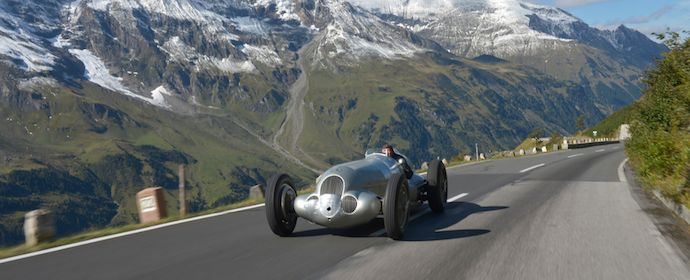The Grossglockner Grand Prix 2012 was held 20 to 22 September on the unique Grossglockner High Alpine Road in Austria. The Grossglockner mountain race was one of the most prestigious motor sports events of the 1930s. This year it was revived and held as a classic car event.
The 2012 Grossglockner Grand Prix was a homage to the legendary “Mountain Grand Prix” races held there in the 1930s.With 92 bends, 14 hairpins, almost 15 kilometres and an altitude difference of almost 1300 metres, the event presented a challenge for man and machine now as they did then. As in the original race, the route was from Ferleiten to Fuscher Torl in Austria.
Mercedes-Benz, who took part in the race for the first time in 1938, shipped over several cars for the revival, including a SSK, a model that was successful in mountain races from 1928 to 1935, and with a W 125 Silver Arrow Grand Prix car from the 1930s. W 125 racing cars took part in the original events in 1938 and 1939, and in 1939 Hermann Lang drove one to victory.
Jump to Grossglockner Mountain Grand Prix History and Period Photos
In the 2012 Grossglockner Grand Prix the driver’s paddock was established at the Ferleiten toll station in line with historical precedent. The field was limited to 50 pre-war cars, 5 Veritas cars and 20 racing cars from the 1950s. The post-war cars participated as an homage to other famous mountain races.
After a practice run, the drivers set their own time target in a “timed run” that had to be confirmed twice. They therefore covered the route four times. The road was understandably closed to normal traffic for the duration of the event.
After the mountain prize, competed for on the Thursday and Friday (20 and 21 September), there was also the option of booking an additional Rally Day for Saturday 22 September 2012. The rally route, known as the “Alpine Challenge” covered 160 kilometres of mountains and valleys in the national park of Hohe Tauern, and also included the Grossglockner High Alpine Road. Speed was never the primary consideration in this event, but rather driving pleasure and an appreciation of the scenery.
The spectacular views from these photos say it all. Seeing these breathtaking cars blitzing through an equally breathtaking location was destined to be nothing short of an unforgettable experience. Since many important old Mercedes like these don’t get used very much, it’s a blessing to get to see them in action, especially on their old stomping grounds.








Jump to Grossglockner Mountain Grand Prix History and Period Photos
Grossglockner Mountain Grand Prix History
The first Grossglockner mountain race took place in 1935. The route was covered only once and immediately rated, the winner being Mario Tadini in an Alfa Romeo. The next two events were held there in 1938 and 1939, and in the “Mountain Grand Prix” the drivers were required to absolve two runs of the pass road. The event was seen as Europe’s longest and most difficult mountain race. The initial plan was to include the complete, almost 38-kilometre long stretch of the high alpine road from Fusch to Franz-Josefs-Höhe, including two tunnels. However, the route was eventually shortened to around 15 kilometres.
Mercedes-Benz first took part in 1938, with Hermann Lang and Manfred von Brauchitsch driving W 125 cars. In adverse weather with fog and rain they achieved 2nd and 3rd place behind Hans Stuck driving an Auto Union. The following year, Hermann Lang emerged the winner of the Grossglockner race, ahead of Hans Stuck and Hermann Paul Müller in Auto Union cars. This brought him the title of “Mountain Champion” six weeks after having already won the Vienna mountain race. Manfred von Brauchitsch had bad luck owing to the changeable weather: on his very first run he encountered a bank of fog in his Silver Arrow and came fourth. In the Grossglockner race the W 125 cars entered by the Mercedes-Benz racing team competed in their mountain racing versions for the first time, with a modified cooling system and lower final drive ratio.




- Grossglockner Mountain Race, 6 August 1939, in difficult weather conditions. Manfred von Brauchitsch in a Mercedes-Benz W 125 mountain racing car with a 5.6-litre engine, starting number 127. He finished fourth.



[Source: Daimler AG]












Another ‘must do’ event. What an opportunity to get those pre-war cars up those mountain roads with clouds and snow lines behind them. Someday i’ll be there, save me a press credential.
Why you dont tell anything about the famous Auto Union cars that won many times those famous mountain race?
Because MB most probably paid the expenses for this article……………
Oooo jummy all the pictures of the 1939 event looks incredible, must have been a terrifying with those small tyres on those narrow wet roads. The colour pics, specially my favourite Mercs, of this year’s event looks almost surreal against the almost black and white backdrop. Brilliant article and I have to agree with Dennis Gray one day I’ll have to be there.
Beautiful photos, but since they were presumably supplied by Daimler-Benz, I’m surprised that they can’t spell Manfred von Brauchitsch’s name correctly.
Thanks for the heads-up Tony. We’ve corrected the errors.